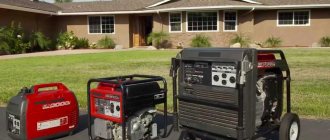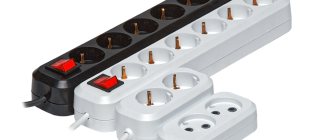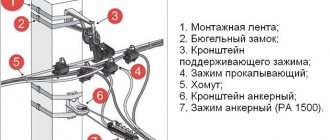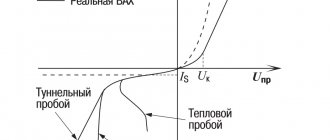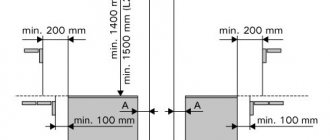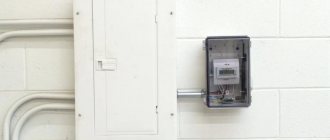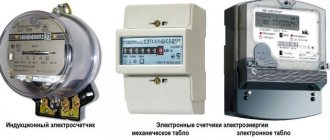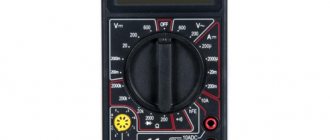Photo: prorabtools.ru
Power outages, unfortunately, are not uncommon these days. If this happens once every six months and lasts about half an hour, they may not cause too much inconvenience. But when, on average, two or three times a month you are forced to arrange a candlelit evening, the situation becomes not at all rosy. There is no lighting, the refrigerator is defrosting, the boiler is not working... This means that you need your own generator for your home. And this can no longer be called just a whim or a desire for increased comfort. This is an adequate assessment of the situation, a way to solve the problem. Of course, we cannot say that a generator is vital for everyone, but in many cases it will help you easily get rid of some unpleasant moments. At the same time, a purchase decision most often comes with a huge number of questions: it is not clear where to start, how to choose from the huge number of offered equipment models exactly the one that will be the ideal option for the task at hand.
Let's start by defining goals
When choosing a generator, the first question that will need to be answered is: “What is the purpose of using it?” Such equipment can serve as the main source of energy. This is necessary if connecting to a centralized power supply network is impossible or does not make sense (for example, at a dacha, at temporary construction sites). But most often, a mini-power plant is used as a reserve in case of an emergency in the main power supply system. When choosing a generator as the main power source, the basis will be such characteristics of the unit as its
- sufficient power,
- relatively long motor life,
- efficiency,
- reliability,
- the presence of an extensive service network,
- compactness and weight (if frequent transportation is necessary),
- ease of use.
In this case, convenience is no less important than, for example, the reliability of the equipment. Few people would like to run to the generator every 3-4 hours around the clock to top up fuel or repair it after six months, leaving the house without electricity. As for efficiency, fuel consumption and cost always become one of the determining factors when choosing any equipment. Finally, the power of the unit must be selected so that consumers do not think about what is currently plugged into the outlet and what else can be turned on without overloading the generator. Most often, a power plant is still required as a backup power source, so we will dwell in more detail on this option.
Top 3. Honda EU30is
Rating (2021): 4.76
The most reliable engine The gasoline generator is driven by a reliable gasoline engine, adapted to difficult operating conditions, which has proven itself well on various gardening and construction equipment.
- Characteristics
Average price: 190,900 rubles
- Country: Thailand
- Motor power: 3.3 kW
- Fuel tank capacity: 13.3 l
- Dimensions (length/width/height): 655/570/480 mm
- Weight: 61 kg
A modern inverter gas generator in a shock-resistant housing, equipped with a reliable four-stroke engine, tested in the most difficult operating conditions. If you follow the manufacturer's recommendations and timely maintenance, the motor will not cause any problems to the owner throughout the entire life of the equipment. The transistor ignition system ensures easy engine starting even at low temperatures. It is worth noting that, unlike most analogues, the assembly production of the device is established in Thailand, which has a positive effect on the build quality. Along with the advantages, there is also a significant drawback - impressive dimensions and heavy weight.
Advantages and disadvantages
- Proven engine
- Build quality
- Rugged housing
- Easy start
- High fuel consumption
What power generator should I choose for my home or cottage?
Approximate calculations will not work in this case, so it is worth paying special attention to this point. The principle is quite simple: it is necessary to add up the power of all individual electrical consumers that must be included in the network at the same time. All the necessary data can be found on labels, nameplates or in the equipment instructions. You can refer to the data provided by the manufacturers (on the Internet today you can find instructions for almost any model of equipment or tool). It is very important to pay attention to the fact that it is necessary to add power values not in the usual kW, but in kVA (kilovolt-amperes). For reference: the total power of the equipment is measured in kVA, which includes the sum of its active (kW) and reactive (kVAr) components. Depending on the operating characteristics of a particular electrical consumer, their ratio may differ significantly from each other, so calculations are made in this way. Also, when determining power, starting currents are of great importance, which for some types of equipment can exceed the rated values by 3-6 times. Starting current is the current consumed by the motor from the mains when starting (i.e. when the device is turned on). So, for example, if you have a pumping station, you should include in the calculations the power of the unit, multiplied by a factor of 3.5-4 (depending on the specific model). The same situation will happen with a refrigerator, air conditioner, and washing machine. To the resulting figure, it is necessary to add a 20-30% power reserve, which will allow the generator to operate in its optimal mode even if all intended consumers are included in the network. Then the nearest larger value is selected from the standard series of generator powers. The issue is resolved.
Photo: www.vseinstrumenti.ru
In most cases, if it is necessary to connect a minimum number of consumers (several light bulbs, a TV and a refrigerator), a gasoline generator with a power of 2-3 kW is chosen. If, for example, you have a workshop at home and require power for several tools, you will need a unit of 6 kW or more. If you frequently use a welding machine, the optimal solution would be to purchase a specialized welding generator.
Why consider the starting current coefficient
This indicator reflects the power of the electrical device that occurs at the moment the engine starts for a fraction of a second after starting. The inrush current coefficient is expressed as a multiplier number (specified in the operating instructions for the specific device). It is denoted as cos φ (cosine phi). It is by this number that the current increases for a fraction of a second during the startup of the electrical appliance.
| Name of equipment | Rated power, W | cos φ | Starting power, W |
| Fridge | 150 | 3,5 | 525 |
| Microwave | 900 | 2 | 1 800 |
| Air conditioning equipment | 1 000 | 3,5 | 3 500 |
| Vacuum cleaner | 1 600 | 1,5 | 2 400 |
| Washing machine | 2 000 | 1 | 2 000 |
| TV | 90 | 1,1 | 99 |
| Water pump | 400 | 3 | 1 200 |
| Laptop | 50 | 2 | 100 |
It is important to remember that cos φ of devices (light bulbs, heaters, electric stoves) that spend energy only on heat is equal to 1. This means that when turned on, their starting power does not increase.
The more powerful the equipment, the greater the load capacity it has, and, accordingly, its cosine phi index is higher. Power tools have a fairly high cos φ: a welding machine - 4, a concrete mixer - 3.5.
What can be connected to a low power generator?
Low-power generators (0.5-2 kW) are in greatest demand due to their relatively low cost, as well as the ability to connect a minimum list of consumers that require high reliability in power supply. With this choice for a home, the first place most often comes from connecting lighting (on average about 6 lamps), a heating boiler, and household appliances (refrigerator, iron, TV).
| 0.5 kW | 1-2 light bulbs, phone charger, laptop/light bulb and TV |
| 1 kW | 2-3 light bulbs, laptop, phone charger/refrigerator and 1-2 light bulbs/1-2 light bulbs and heating boiler (stabilizer required) |
| 2 kW | 3-4 light bulbs, boiler, laptop, refrigerator, phone charger, TV |
Rating of TOP 10 best models
| Place | Name | Price |
| TOP 10 best 3 kW gasoline generators | ||
| 1 | BISON ZIG-3500 | 37 000 ₽ |
| 2 | Huter DY4000L | 17 000 ₽ |
| 3 | Huter DY4000LX | 21 000 ₽ |
| 4 | BISON ZESB-3500 | 21 000 ₽ |
| 5 | Fubag BS 3300 ES | 24 000 ₽ |
| 6 | Fubag BS 3300 (838753) | 19 000 ₽ |
| 7 | Eurolux G4000A | 12 000 ₽ |
| 8 | PATRIOT GP 3000iL | 40 000 ₽ |
| 9 | BISON ZESB-3500-EM2 | 25 000 ₽ |
| 10 | Sturm! PG8735 | 18 000 ₽ |
Petrol, diesel or gas?
One of the fundamental points in choosing a generator, which follows from the previously obtained power value, is the type of fuel used in the operation. There are only two clear situations in this case:
- if you need a generator with a power of up to 2-3 kW, in this case you need a gasoline model,
- if the equipment power is more than 15 kW, then diesel is your option.
For both situations, there is only one explanation: electric generators running on other types of fuel are not produced.
As for intermediate indicators, everything is a little more complicated. Often the cost of the equipment and its subsequent operation, as well as the features of its future application, are decisive.
Gasoline generators
Photo: invertor-generator ru Petrol generator FUBAG BS 1100
The main characteristics of such equipment are
- compactness,
- ease of transportation,
- low cost mini power plant,
- low noise level,
- higher fuel costs,
- resource from 500 to 3000 hours (depending on model and brand).
This option is perfect for situations where constant transportation of the power plant is required; its switching on occurs rarely and for a short time.
Separately, I would like to draw attention to the value of the “motor resource” indicator when choosing equipment. This figure indicates the number of hours after which the equipment must undergo scheduled comprehensive maintenance. Simply put, the number of engine hours is the average duration of operation of the generator between repairs according to testing data of the selected model by the manufacturer.
Inverter generators
Photo: www.toool.ru Inverter gas generator HUTER DN2700
Inverter-type gasoline generators are one of the best options when choosing equipment in this class. They differ from traditionally designed equipment by the presence of an engine speed controller and an electronic ignition system. At the same time, the efficiency of such units is due to the fact that the number of revolutions changes depending on the load, which allows for significant fuel savings. As a result, the electronics completely control the level of generated voltage.
Diesel generators
Photo: www.ers-energo.ru Diesel generator SDMO DIESEL 4000 E
In this case, there is a choice between a stationary and portable installation (in other words, between a water-cooled and an air-cooled power plant). Air diesel generators are great for frequent power problems as a backup. They have a service life of about 4000 hours, are economical to operate and can withstand more intense operating conditions compared to their gasoline counterparts.
If all the benefits of civilization are far away and there is a high probability that problems with power supply can arise at any moment and last for an unknown amount of time, a stationary water-cooled diesel generator is what you need. To say they are reliable is an understatement. They can work around the clock, and the service life is 40,000 hours. Another feature of them is their weight (most often it is about 200-250 kg), although this can also have its “plus”: it will be very difficult to steal such a generator even with a strong desire difficult.
Gas generators
Photo: www.toool.ru Gas generator KIPOR KNE5500E
Recently, gas generators have become a worthy (though not yet very widespread) alternative to units running on gasoline or diesel. Its main advantages can be called
- low cost of fuel (it is also very convenient that there is no need to monitor the fuel level in the tank, especially when the generator runs on natural gas);
- high efficiency;
- low noise level;
- environmental friendliness.
Flaws
- high cost of equipment;
- the difficulty of transporting liquefied gas (in the absence of a source of natural fuel);
- complex safety measures during operation;
- difficulty connecting to the main line;
- connection requires specialists with experience in performing such work.
The best 3 kW gasoline generators
BISON ZIG-3500
This is a powerful, silent, inverter, synchronous gas generator . Suitable for supplying retail facilities, partial
energy supply of a private or country house.
Equipped with a special economical mode, which reduces fuel consumption when the unit is not fully loaded.
There is a protective automatic engine shutdown when the oil level is low.
The generator is equipped with a full-fledged four-stroke single-cylinder engine, which is easy to operate, has a long service life, is economical and environmentally friendly.
Characteristics:
- launch type - manual;
- voltage - 220 V;
- engine volume - 149 cubic meters. cm, power - 5.7 l. With.;
- tank volume - 5.7 l;
- active power - 3 kW, maximum - 3.5 kW;
- sockets - 2 for 220 V, 1 for 12 V;
- weight - 30 kg.
Advantages:
- effective overload protection;
- air cooling;
- Autonomous operation for 3.1 hours;
- built-in indicators;
- mobility;
- quiet work.
Huter DY4000L
Synchronous petrol generator with manual start based on the Huter 170F engine . You can use gas instead of gasoline. Unit
supplies electricity to household appliances, gadgets, professional equipment, and power tools.
Thanks to the protection and control system, safe operation and stable, high-quality output voltage are observed.
The generator belongs to the family of mini-power plants . Their design was developed by German engineers using modern stands.
The products were able to fully satisfy the needs of users.
Characteristics:
- voltage - 220 V;
- engine type - single-cylinder, four-stroke, power - 7 liters. With.;
- fuel consumption - 395 g/h;
- tank volume - 15 l;
- active power - 3 kW;
- sockets - 1 for 220 V;
- dimensions - 60.5x43.5x45 cm;
- weight - 45 kg.
One or three phases?
This question is as important as the previous ones, because a single-phase and three-phase generator are completely different devices that have their own conditions for operation and application. There is simply no answer to the question of which is better. Each individual situation has its own variant.
Photo: donelektrik.ru Single-phase network diagram
- If there is not a single three-phase consumer in the house and the centralized power supply is supplied through one line, the conclusion is clear: a single-phase generator is needed.
- A single-phase unit is also needed when three lines are connected, but only one needs to be reserved (if, for example, a heating system, refrigerator, pumping station, etc. is connected to it).
- If you have single- and three-phase consumers, you can go in two ways: buy two power plants of different designs or still one three-phase, but be sure to ensure that the loads between the lines are distributed evenly.
Photo: donelektrik.ru Three-phase network diagram
If 3 phases , there are also two options:
- Buy a 3-phase power plant and a 3-phase automatic transfer switch (automatically entering a reserve, which will automatically turn on the generator when the power in the centralized network disappears). In this case, it is necessary to lay separate lines in which a uniform distribution of loads between them would be provided, and their sum would not be more than a third of the total power of the unit (if the generator is designed for 15 kW, not more than 5 kW).
- 1-phase generator and 3-phase ATS in the absence of three-phase consumers. In this case, if necessary, the automation will connect all the phases of the network with the generator, and the unit will simultaneously power each of them. At the same time, you no longer have to worry about ensuring that the loads are evenly distributed.
It is important to consider when connecting a three-phase unit to the network that the maximum permissible phase imbalance is 25% of the power. If this rule is not followed, the generator will simply fail.
Just something complicated. How to choose a generator?
In this article, we have collected all the necessary minimum knowledge about generators, which will allow you not to make a mistake when choosing one.
Before you start choosing a generator, you should clearly decide which parameters are most preferable to you. When purchasing a device, you need to take into account its weight, dimensions, operating time, automation, noise level, fuel consumption, power and, of course, price.
How many phases should a generator have?
In order to answer this question, it is necessary to understand which consumers will be connected to the electric generator. Only single-phase consumers can be connected to a single-phase power plant. Both single-phase and three-phase can be connected to a three-phase power plant. But this property does not mean that three-phase power plants are always better. It must be remembered that for most generators the maximum permissible load on each phase should not exceed 30%. In practice, this means that you cannot remove more than one-third of the rated power from a single-phase socket of a three-phase generator. Those. if a three-phase generator has a rated power of 6 kW, then you can remove no more than 2 kW from a 220 V outlet. In addition, when connecting consumers to three-phase power plants, it is necessary to achieve uniform distribution of loads across phases.
As a result, it is best to take a three-phase station only when you have a three-phase consumer. If all consumers are single-phase, then in the vast majority of cases it is worth choosing a single-phase generator.
How to calculate the required generator power?
Power is one of the main parameters that need to be taken into account when choosing a generator. To determine the required power of the electric generator, you should check the power of the devices that will be connected to it. It must be taken into account that the power of the electric generator must exceed the sum of the powers of all simultaneously connected devices that will operate for more than five minutes by 20-30%. This is due to the fact that the power plant will operate in the most optimal mode only when the load connected to it does not exceed 40-80% of the rated power.
If the generator power is selected incorrectly, then you are likely to encounter:
- overloading the generator and its subsequent shutdown;
- reduced service life due to prolonged operation at extreme conditions;
- high fuel consumption.
By selecting the power correctly, you will be able to connect previously unforeseen consumers to the network powered by the power plant.
Watts, volt-amps and power factor
Please note that power can be measured in watts (W) and volt-amperes (VA). If the instructions for the device and the instructions for the generator indicate power in different dimensions, then it is worth converting both values to a common unit of measurement. To convert kVA to kW, the value in volt-amperes must be multiplied by the power factor (cos ȹ).
Let's say we have a power plant with a capacity of 3 kVA and a power factor of 0.8; Having made simple calculations by multiplying 3 by 0.8, we find out that the power of this installation is 2.4 kW. Now let’s calculate what power vacuum cleaner can be connected to it. Typically (cos ȹ) of a vacuum cleaner is approximately 0.5. In total, let’s calculate the power of the vacuum cleaner: 3 × 0.8 × 05 = 1.2 kW.
What should be the power of a heater that can be connected to the power plant described above? Since the heater has no reactivity, its power factor is equal to the same. Let's multiply: 3 kVA × 0.8 × 1 = 2.4 kW. That is, the power of the heater is the same as the power of the power plant itself.
Resistive, inductive, capacitive...
To correctly select a generator, it is important to know the resistive, inductive or capacitive devices you are going to use. Resistive devices consume current with active power, simply those that do not have an electric motor. These include heating appliances, incandescent lamps, and stoves. For this type of device, any generator of appropriate power is suitable, since they completely convert the consumed power into light or heat.
Inductive devices are devices that are powered by an electric motor. For example, a compressor, pump or sawmill. This type is characterized by power loss due to winding friction, so only 70% of the original value is used as useful power. Also, in inductive devices, additional power is required to start the motor. Therefore, when working with such devices, it is better to have a generator power reserve of about 20%.
If you purchase a power station to connect inductive devices to it, you should definitely find out what maximum current it can withstand.
Capacitive devices are the most sensitive current consumers (for example, professional discharge lamps, flash lamps). To work with such devices, exclusively asynchronous generators are used.
Starting current
Inrush current is the current that occurs for a short period of time after starting equipment equipped with an electric motor. The starting current can be several times higher than the rated power of the unit. The value of this current can be found in the device data sheet. For approximate calculations, you can use the following table:
| TV | 1 | Electric planer | 2 |
| Kitchen stove | 1 | Angle grinder (grinder) | 2 |
| Coffee maker | 1 | Grinder | 2 |
| Heater | 1,2 | Electric saw | 2 |
| Incandescent lamps | 1 | Drill | 3 |
| Vacuum cleaner | 1,2 | Boiler, boiler (Boiler) | 3,4 |
| Microwave | 2 | Concrete mixer | 3,5 |
| Washing machine | 3,5 | Hammer | 3 |
| Computer | 2 | Air conditioner | 3,5 |
| Fridge | 3,3 | Submersible pump | 7 |
| Freezer | 3,5 | Electric meat grinder | 7 |
| A little trick - if you connect the equipment not directly to the generator, but through a fairly thick and long extension cord wound into a coil (you need to wind the wire in turns, say, on a stick), then in this case the extension cord behaves like a choke (an inductor with a high AC resistance current) and starting currents at the generator input are significantly reduced. |
How to choose the right power?
Thus, when choosing a generator you need:
- determine what devices you will connect to the generator;
- determine the power of these devices (usually this can be read in the instructions or on the devices themselves);
- know the inrush current coefficients for these devices;
- Based on the type of device and its power, calculate the required power of the unit.
If you cannot find out exactly what power the devices you are going to connect are, use the following table of approximate values:
| Fridge | 0.1-0.3 kW | Microwave | 1 kW |
| TV | 0.08 kW | Electric kettle | 2 kW |
| Washing machine | 1.5 kW | Vacuum cleaner | 0.8 kW |
| Iron | 1 kW | Incandescent lamps | 0.04-0.1 kW |
| LCD monitor | 0.02-0.06 kW | CRT Monitor | 0.07-0.2 kW |
A simple example of calculating generator power
We need a backup generator for the dacha, so that when the lights are turned off for a couple of days again, the refrigerator does not turn into a foul-smelling box for vegetables and meat, and in the dark you can walk around the rooms without fear of injury. It would also be great to watch TV and vacuum the floor sometimes.
The total power of the devices we have listed will be approximately 1.5-2 kW. Let's look at the type of load placed on the power source (generator). To do this, let's look at the table of starting currents, and after that we will calculate the required power for the simultaneously connected consumers of electricity listed above (take the maximum values): 0.3 kW × 3.3 + 0.2 kW (two 100 W lamps) × 1 + 0.08 kW × 1+0.8kW×1.2=2.23kW. And because Usually the maximum power of a generator (the power it can produce for a short period of time) usually exceeds its rated power, for our purposes we can easily take a 2 kW generator.
Fuel consumption
Do you need to determine the fuel consumption of a power plant? You need to know the power of the generator in kW. Consumption in g/kW*hour multiplied by the generator power in kW gives consumption in g/hour. To get in liters/hour you need to know the specific density of the fuel in g/liter (for AI-95 (A-95) approximately 750 g/liter, for diesel fuel 840 g/liter), i.e., divide the consumption in g/hour by density in g/liter. For example, gasoline consumption is 350 g/kW*hour. Generator power 5 kW. Those. fuel consumption at full power - 350x5=1750 g/hour. We divide the resulting amount by the density of gasoline (in our case AI-95) 750 g/liter and we get 2.3 l/hour.
When accurately calculating consumption, it is also worth taking into account the change in fuel density when the external temperature changes. The tabulated fuel density is indicated at nominal temperature (20 degrees Celsius). The lower the temperature, the lower the density.
Synchronous and asynchronous generators
Synchronous generators have a lower current quality compared to asynchronous ones, but, nevertheless, they are suitable for emergency power supply of offices, refrigeration units, equipment of country houses, summer cottages, and construction sites. Such generators are more resistant to short-term overloads, but are poorly protected from water, dust and dirt since they draw air through them for cooling. The main advantage of such electric generators is that they handle peak loads relatively painlessly. Those. To operate devices with a reactive load (having an electric motor), you will need a generator of lower power (compared to an asynchronous one).
Asynchronous generators do not tolerate peak loads well, but they ensure that the voltage in the network is maintained with high accuracy, so they allow you to connect equipment that is sensitive to voltage surges (for example, medical equipment, computers, other electronic devices). The source of electric current in them is the residual magnetization of the rotor. Thanks to this principle, asynchronous generators are more durable: they do not require air cooling and their housing is completely closed and protected from moisture and dust. Due to their immunity to short circuits, such generators are an ideal power source for welding machines. But they are sensitive to overloads and are not suitable for powering power tools and other devices with high inrush currents.
What kind of engine do you need?
The engine is the main part of the unit; how long the power plant will last depends on its potential. Engines are petrol, diesel and gas. The service life of an air-cooled generator with a gasoline engine is approximately 500-800 operating hours for a Chinese gasoline engine, up to 2,000 thousand operating hours for Honda, Briggs & Stratton or Kohler engines. The service life of diesel engines significantly exceeds this figure and ranges from 2500 operating hours for an air-cooled engine and 3000 rpm to 20,000-30,000 for liquid-cooled engines and 1500 rpm. The service life of gas engines is much longer than that of gasoline engines and approximately the same as that of diesel engines. The service life of an air-cooled gas engine is 1500-2000 operating hours for Chinese engines and about 3000-4000 thousand for Japanese, European and American engines. As for liquid-cooled engines, their service life starts from 10,000 operating hours for small displacement engines, up to 40,000-50,000 operating hours for large displacement engines.
Gasoline engines are usually used on medium and low power generators. Cheap generator, low resource. This is a great option if you rarely lose power. Diesel engines are used for backup power supply of medium and high power. Quite an expensive generator with a good resource. Most often used in construction or reserve of large objects. Gas-fired ones are ideal for backup power supply to homes and industries. Gas generators are more expensive than gasoline generators and cost about the same as diesel ones. But unlike both, they have serious advantages: if there is a main gas pipeline, the cost of 1 kW/h will be cheaper than that of gasoline and diesel engines, which means that during intensive use the generator will pay for itself much faster. In addition, for liquid-cooled gas generators, the cost of 1 kW/h (taking into account the cost of the station and the cost of its maintenance) is always lower than the cost of 1 kW/h from the city network. On average, this is from 1.5 to 3 rubles per 1 kW/h. And this is not to mention the fact that the gas engine is noticeably more environmentally friendly than both gasoline and diesel engines. For example, when working on methane, the smell of exhaust gases is practically not felt, and this is important for a country house.
| Cost of fuel to produce 5kW in 1000 hours | |
| Petrol | RUB 128,047 |
| Diesel | RUB 79,674 |
| Propane-butane (cylinder) | RUB 49,756 |
| Methane (main) | RUB 12,764 |
Operating mode
Correctly determining the operating mode of the generator will allow you to use its resource most efficiently.
| ENGINE'S TYPE | MOTORRESURS | ADVANTAGES | MODE OF USE |
| Gasoline engines, air-cooled, 3000 rpm | 700-2000 m/h | Lowest cost watt/ruble ratio. Low noise and vibration levels. | Backup or emergency source of power supply, when operating up to 100 hours per year. Or as a permanent source for a period of up to 2 months. |
| Air-cooled diesel engines, 3000 rpm | 2500-3000 m/h | Twice the lifespan of air-cooled gasoline engines. Low response to load changes. Reliable launch. | Emergency power supply for use in places where there is no gasoline or for emergency work. |
| Liquid cooled diesel engines, 3000 rpm | 7000-10000 m/h | Quickly warm up the engine before connecting the load. Reliable launch. | Backup source of energy supply, during operation up to 1000 hours per year. Or as a permanent source for a period of up to 6-9 months. |
| Liquid cooled diesel engines, 1500 rpm | 15000-20000 m/h | High motor potential. Economical. Low noise and vibration levels. reliable start. | A backup and permanent source of supply for a long time (about 10 and 2 years, respectively). |
| Air-cooled gas engines, 3000 rpm | 1500-4000 m/h | High engine life, quick engine warm-up. Low cost kW/h. | Backup source of power supply with low cost kW/h. |
| Gas engines, liquid cooled, 1500 rpm | 10000-40000 m/h | High motor potential. The cost of 1 kWh is lower than that of the main network. | Backup or permanent source of power supply. With constant operation, the payback period is from 7 to 15 months. |
All data presented in the table are approximate and do not apply to a specific power plant.
Fuel safety
It is important to remember that long-term storage of gasoline (more than 6 months) deteriorates its properties, which can lead to loss of power or even engine failure. Don't forget to change it every 3-4 months if you don't use a generator. Diesel fuel is more resistant to long-term storage.
Generator for a summer residence
Which generator to choose for your dacha? First of all, you need to decide how much total power the appliances in your home consume. Above we calculated the minimum required power, for an “average” country house - 2 kW. But you don’t want to have to calculate watts every time, and even if limiting yourself, still use all the main electrical appliances at home. In practice, for a house inhabited by 4 people, the optimal generator power is 4-5 kW. It will be enough for basic household appliances at home (you may even forget that in the entire holiday village, no one except you has electricity).
What is better, save money and take a device from China, or still shell out the required amount and buy a generator made in Europe/Japan? The answer is not as obvious as it might seem at first glance. First of all, it depends on how often the generator will operate. The engine life of a modern Chinese-made generator is 1-1.5 thousand hours. If the electricity is turned off a couple of times a month for 6 hours, then you yourself can easily calculate that with such intensity of operation, the resource will last for 15 years. If a budget generator can easily meet your needs for the foreseeable years, is it worth overpaying for a better one ( and therefore an expensive) brand? It's up to you to decide, but I don't think there's much point.
When is it wrong to save money on a generator? First of all, when you plan to use it extremely intensively. For example, electricity is supplied only periodically and the generator will run for several hours every day. In this case, the quality of the generator and the reliability of its operation fully pay for the money spent on it.
Generator for welding machine
The correct selection of a generator for a welding machine must take into account a huge number of different data, such as the maximum welding current, power, current curve, etc. of welding machines. The starting currents of the welding machine are so aggressive and instantaneous that the generator fuses do not have time to melt and the alternator burns out. For simplicity and reliability, the generator power should be chosen three times greater than the power of the welding machine. There is also a second way. Before connecting the welding machine to the generator, turn the welding current to a minimum and only then connect it to the generator. It is worth considering that a 5 kW generator is ready to withstand welding current within 160A. Increasing the current above this value increases the likelihood of generator failure.
Price-quality ratio
Planning a major purchase always involves looking for the best value for money. Today, electric generators produced in countries such as France, Germany, the USA and Japan (SDMO, Endress, Generac) are famous for their high-quality units, a good assortment, the highest quality, but not very affordable prices. This is high quality and reliable equipment. But don't discount generators made in China. Some brands are very close in quality and reliability to their European/Japanese/American counterparts (for example, Ergomax, Kipor, Huter), and the price is two to three times cheaper. There are also brands that are between these two categories - for example, the Russian-Chinese TCC or the German-Chinese Fubag. European production culture and high-quality components make their products the best in their class. Among the gas generators, in addition to Generac, one can highlight the Russian-made Gazvolt generators. A distinctive feature of these generators is that they were originally designed for Russian operating conditions - all generators in the database are equipped with a set for winter operation, which allows for reliable starting at low temperatures (and this is especially important for gas engines), and are also configured for Russian gas.
If we talk about specialization, it is better if it is a company that is exclusively engaged in the production of generator sets. Since this type of business is highly specialized, do not count on finding a company name that everyone knows. It is also worth considering that low-power units produced by branded companies can be unreasonably expensive. Make sure that the company producing the generators has quality certificates and its products meet international standards.
Before you buy an electric generator, think about how competent you are in this matter. If you are tormented by doubts, it is better to seek help from a specialist. If you know exactly what you want, have taken into account the device parameters you need, have studied the market and decided on the price, do not forget to think in advance about possible repairs and carefully check the warranty documents when purchasing.
Device management options
- Manual start. This type of starting is most often used in low-power generators. In order to start the unit, you will need to strongly pull the cord/twist the handle/press the starter pedal. It must be admitted that this is quite inconvenient and will require considerable physical effort.
- Electric start. With this design, to start it will be enough to simply press a button on the panel.
- Autostart. In this case, when the mains power goes out, the generator will start automatically without operator intervention, and then turn off when power is restored with a set time delay. The only thing that needs to be taken into account for this version is that the automation will not work if the temperature is less than +5 ˚С, so it is necessary to either install the equipment in a heated container or in a heated room.
Generator fuel consumption
Regardless of the type of equipment, fuel consumption directly depends on:
- from the load connected to the unit,
- efficiency of a specific model,
- fuel quality,
- clogged oil and fuel filters.
On average, a gasoline unit can consume 0.3÷0.45 kg/kWh, and a diesel unit 0.184÷0.220 kg/kWh.
Photo: www.elitech-tools.ru
Electric generator maintenance
In order for the generator to operate reliably and efficiently for a long time, maintenance is necessary. All activities that are required to be carried out, as well as their frequency, are always prescribed in the manufacturer’s operating instructions. The scope of such work largely depends on the brand of equipment, its features, its components and their quality.
On average, the maintenance frequency is 250-300 engine hours. At the same time, it is important to periodically check the condition of oil, air and fuel filters, oil, ventilation systems, belt tension, etc. If necessary, the elements are cleaned or replaced.
Watt, kilowatt and kilowatt-hour
The unit of measurement watt got its name in honor of the scientist James Watt, who studied electricity in the nineteenth century. It is he who is credited with the invention of the universal steam engine.
Today, any power is measured in watts, not just electrical power. For example, to measure the power of a car engine, watts are also used along with horsepower. However, most often it is not the “watt” itself that is used, but its derivative, the kilowatt (kW). By analogy with the meter and kilometer, as well as with the gram and kilogram, one kilowatt is equal to a thousand watts.
Energy is often also calculated in other units, multiples of the watt. For example, to measure high power it is convenient to use the megawatt, a unit that corresponds to a million watts. You can also use other prefixes of the international system of units, including those that correspond to tenths, hundredths, thousandths.
For example:
- deciwatt is a tenth of a watt;
- centiwatt - its hundredth part;
- A milliwatt is a thousandth of a watt.
The electric power that is consumed by ordinary household appliances such as lamps, refrigerators, and TVs is best measured in kW. If the watt and its derivative units are included in the SI system, then the kilowatt-hour is not there. KWh is a unit of measurement that is non-systemic. It was created only to keep track of the electrical energy produced or, conversely, used.
The use of kWh on the territory of the Russian Federation is regulated by GOST, which clearly indicates the name, designation and area in which it is used. A kilowatt-hour can be designated either by four Russian letters or three English ones. The Russian designation is “kWh”, and the English designation is “kW h”.
You might be interested in: Electrician safety precautions when working with electricity
Popular manufacturers
Choosing a brand of equipment is one of the most important tasks. Among the most popular are
- Honda , which is distinguished by high and stable production quality, as well as the ability to select equipment for difficult working conditions, low noise levels, easy starting, good traction and power performance.
- Kipor is one of the highly reliable Chinese brands with a large range of gasoline and diesel units, which is in demand due to its relatively low cost and is perfect for use at home or in the country.
- Huter is a brand that appeared on the Russian market relatively recently and is distinguished by its low cost, reliability and stability, and a wide range of models, including gas units.
- Zubr is a Belarusian brand that is on par with the world's leading brands at an optimal price level.
Hyundai , SDMO , Wilson , DDE and FUBAG are also widely represented on the market . It is also worth paying attention when choosing a specific model and manufacturer to the availability of a developed network of technical service centers for this equipment in order to protect yourself from lengthy searches for the necessary specialists and spare parts.
